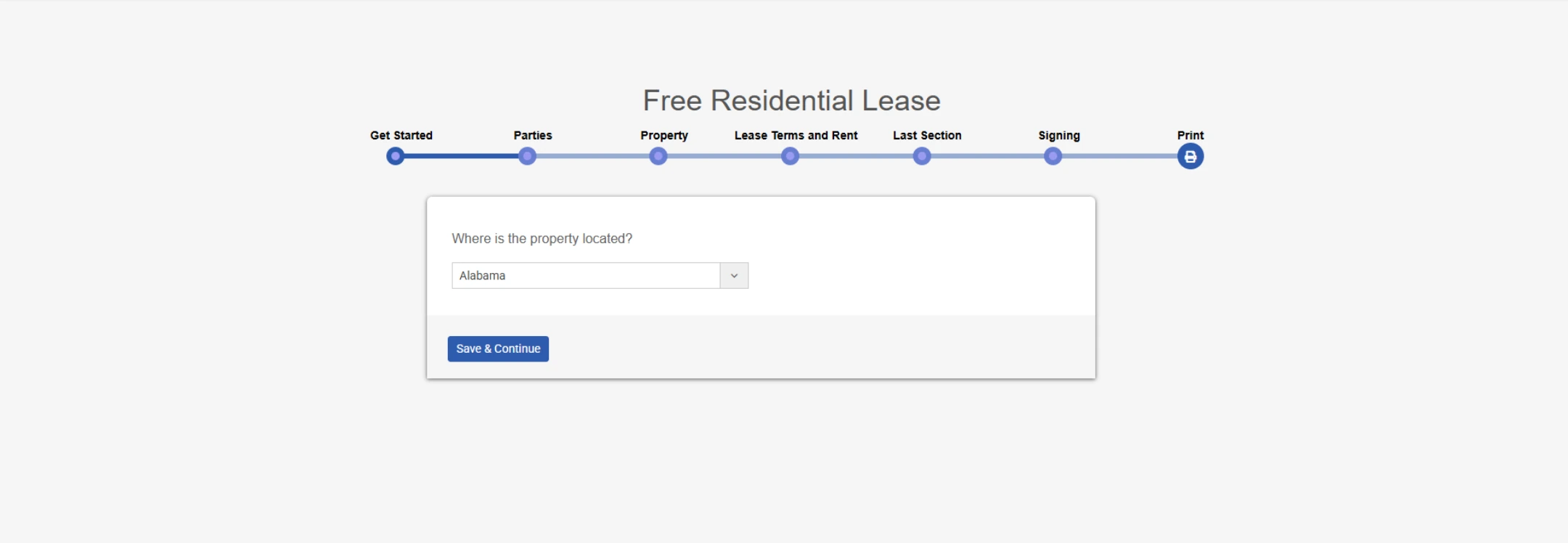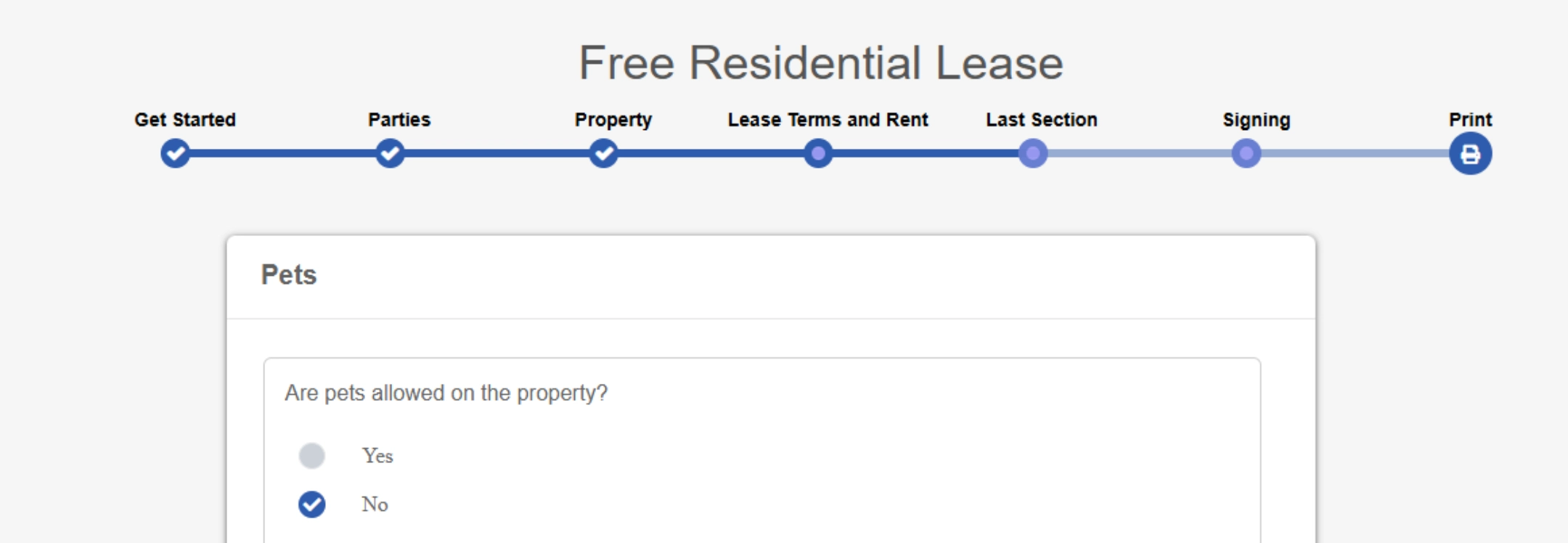- Using generic or outdated lease templates risks missing essential terms and legal compliance
- Vague rent and payment provisions lead to tenant disputes and cash flow interruptions
- Omitting key clauses on repairs, subletting, pets, or renewal exposes landlords to avoidable liabilities
- Ignoring legal requirements for habitability, entry notices, and deposit rules can trigger fines and lawsuits
- Professional platforms like Ziji Legal Forms help landlords craft accurate, compliant residential lease agreements
Introduction: Why Residential Lease Accuracy Matters
Mistake #1: Using Generic or Outdated Lease Templates
How Generic Templates Fail
Mistake #2: Vague Rent and Payment Terms
Consequences of Unclear Payment Provisions
Mistake #3: Overlooking Key Clauses
Essential Clauses to Include
- Maintenance and Repair Responsibilities: Define landlord and tenant duties for upkeep and repairs
- Guest and Subletting Policies: Set limits on long-term guests and require landlord approval for sublets
- Pet Rules: Specify allowed pets, additional deposits, and behavior standards
- Renewal and Termination Terms: State notice periods, automatic renewal conditions, and holdover rent rates
Mistake #4: Failing to Address Legal Requirements
Critical Legal Provisions
- Habitability Standards: Guarantee working utilities, safe structures, and pest-free environments
- Notice Before Entry: Specify required advance notice for inspections, repairs, and showings
- Fair Housing Compliance: Prohibit discrimination based on protected classes
- Security Deposit Rules: Outline caps, holding procedures, and timely refund obligations

How to Create a Lease Using Ziji Legal Forms
1. Choose your state to generate a compliant residential lease form.

2. Respond to a few guided questions about your property, rent amount, and terms.

3. Customize required additional clauses (utilities, pets, allowing smoking, etc.).

4. Preview and download the residential lease document.

5. Have all parties sign electronically or in print.
Benefits of Using Ziji Legal Forms
- Customizable Templates: Tailor free simple residential lease agreement forms to your properties
- Compliance Alerts: Receive real-time prompts for missing clauses and legal updates
- Instant PDF/Word Download: Generate professional residential lease agreement pdf documents ready for signatures
- Streamlined Workflow: Save, edit, and manage multiple residential lease forms in one secure platform
Conclusion
Residential Lease FAQs
What is a residential lease agreement also known as?
A residential lease agreement is also known as the following: rental contract, rental agreement, residential lease, residential tenancy agreement, or tenancy agreement.
No matter which term is used, it is referring to a lease for a non-commercial property used for residential dwelling purposes. For example, a residential lease can be used to rent out a room, basement suite, apartment, condo, house, duplex, townhouse, or mobile home.
What is a residential lease and why do you need one?
A residential lease is a lease between the landlord and tenant that outlines and sets out the terms of the tenancy, including the rights and responsibilities of the parties. The typical lease will cover the following points:
- what type of rental property it is
- how much the rent is, how it will be paid, and how often it will be paid
- how long the term of the lease is
- how much the security or damage deposit is, if any
- the cost of utilities or if any are included in the rent
- what appliances are included in the lease, if any
- subletting or assigning rights by the tenant, if any
- provisions for termination of the lease
Some people may think a verbal lease is sufficient, however they are extremely difficult to enforce since there’s no written proof should the parties appear in front of a landlord and tenant board or a court during dispute. A written lease will demonstrate the intention of the parties and will protect them if any of the terms are breached when they seek remedies from the landlord and tenant board or from the court.
Having the terms of the lease in written form ensures both parties know what their obligations are and eliminates any ambiguity and can potentially prevent disputes for both the landlord and tenant.
What’s the difference between a residential lease and a commercial lease?
Residential lease is only applicable to residential property where people live as their home and not for commercial property. Virtually all jurisdictions have statutes and/or bylaws outlining rules and regulations that protect both the landlord and the tenant. By using a residential lease those basic minimum regulations are incorporated into the lease.
What is the Governing Law in a lease?
The governing law is the law of jurisdiction where the property is located. This is to ensure clarity and validity for the landlord and tenant. It doesn’t matter where the parties came from or currently resides, if there’s a dispute, the laws of where the property is located will be used to interpret the lease.
Who are the parties in a lease?
The lease needs to have a landlord (the lessor) and a tenant (the lessee) in order to be valid. The landlord is the one renting out the property to the tenant in exchange for rental payments.
There can also be a guarantor to the lease. The guarantor is someone that agrees to pay the tenant’s rent if the tenant fails to pay. A common example is a young college student signing a lease and having his or her parents as the guarantor to pay in case of default.
Who can live in the rental premises?
Only the tenants listed on the lease may reside in the premises. Any children or minors under the supervision of the tenant are automatically included even when their names are not on the lease. The tenant may also have reasonable overnight guests to stay in the premises, however any abuse of it may constitute a violation of the lease. For example having someone live in the premises permanently and is not listed as a tenant.
What are the landlord’s obligations?
In addition to any terms defined within the lease, the landlord’s most basic obligations are to maintain the property and to meet the basic health and safety standards of the jurisdiction where the property is located to ensure that it is liveable. Moreover, the landlord must not disrupt the tenant’s peaceful and quiet enjoyment of the property.
What are the tenant’s obligations?
In addition to any terms defined within the lease, the tenant’s most basic obligations include paying the rent on time and to maintain the property in a good state and to ensure that no damage is caused to the property.
What is a lease term and which one should you choose?
The lease term is the duration of time the lease is in place. Basically, it’s how long the lease will last from start to finish. There are two main types of lease terms:
Periodic Tenancy
Periodic tenancy has a start date but no end date, and it will continue until either the landlord or the tenant gives written notice to end it. The typical duration of a periodic tenancy is month-to-month. However, it can also be week-to-week or year-to-year.
The benefits of a periodic tenancy are as follows:
-
Ability to increase rent
In many jurisdictions, the landlord can raise the rent during a periodic tenancy as long as proper notice is given. Check with your local rental laws to confirm the requirements. This allows landlords in hotter rental markets to maximize their profit.
-
Flexibility to move and screen for quality tenants
For a landlord who is new to rental business, having a flexible end date allows one to have more control over who is living in the property. In cases where the tenant is not ideal, it is easier to ask a tenant to move out. This is especially beneficial when a new landlord is not proficient in the tenant screening process. For the tenant, a periodic tenancy offers the flexibility to move on a shorter notice to accommodate their needs and changes in life.
The cons of a periodic tenancy area as follows:
-
Less certainty in rental income
Having a periodic tenancy means the tenant can move out at any time when a notice is given. This will provide less stability in the rental income for the landlord since he/she has less control over the vacancy rate of the property.
-
Shorter notice to find and screen for new prospective tenants
Most fixed term tenancy is a year long. While most periodic tenancy is month-to-month and in most jurisdictions a 30 day notice is sufficient for the tenant to move out. So generally speaking, the landlord will have less time to find and screen for new tenants in a periodic tenancy if he/she wants to avoid having a vacant rental unit. Moreover, during certain periods of the year, such as the winter months, it is notoriously slower and more difficult to find new tenants. These factors can negatively affect the cash flow of the rental unit for the landlord.
Fixed Term Tenancy
Fixed term tenancy starts and ends on a designated date. For example a lease could start on Jan 1, and end on Jan 1 the following year. The typical length of a fixed term tenancy ranges from 6 months to 1 year. However it can also be longer like 2 to 3 years. In most jurisdictions, once a fixed term tenancy ends and if the landlord or the tenant does not terminate the lease, the lease automatically becomes a month-to-month periodic tenancy.
The benefits of a fixed term tenancy are as follows:
-
More certainty in rental income
The tenant will be responsible for the whole duration of the lease unless both the landlord and tenant agree to end the lease. Since most fixed term tenancy are at least a year long, there is much more certainty in the rental income for the landlord with less potential vacancy than month-to-month lease. This allows the landlord to forecast the cost and budget expenses accordingly.
-
Longer notice to find and screen for new prospective tenants
Most fixed term tenancy is a year. Generally, the landlord will have more time to find new tenants.
-
Fixed rental rate for the tenant
In most jurisdictions, the landlord cannot increase the rent for a fixed term lease until one year has passed. So fixed term tenancy offers more rent certainty for the tenant.
The cons of a fixed term tenancy are as follows:
-
Harder for landlord to remove tenant
If the tenant is less than ideal, the landlord will generally have to wait till the end of the fixed term lease to remove the tenant.
-
Tenant is stuck with the lease
This problem of having a longer fixed term lease goes both ways. Just as a landlord might have to put up with a less than ideal tenant, the tenant might run into neighbours or landlord/rental managers that may negatively affect the quality of life, but the tenant will be stuck until the lease ends or have to go through the trouble of subletting the property. Moreover, the tenant’s life situation may change with a new job, job loss, break up, family emergency etc and a fixed term lease that’s generally longer makes it more difficult for the tenant to leave.
What’s a notice to entry and how long is the required notice?
Unless there’s an emergency situation in the rental unit (e.g. water pipe bursting, fire etc), the landlord cannot enter the rental unit without the tenant’s permission. In order to enter the rental unit, the landlord must provide a notice of entry or notice to enter in written form to the tenant. The landlord has a right to enter the rental property to make inspection of the unit, to perform repairs, and to show the rental unit to contractors, prospective new tenants and buyers. In most jurisdictions, the landlord needs to provide a 24 hour notice before the inspection and the inspection should take place during business hours between 9 a.m. to 5 p.m. local time. Consult your local laws to the proper notice as defined by statute.
What is subletting and assignment of a lease?
Sometimes the tenant may no longer need the rental unit (e.g. new job in a different city, needing to downsize etc.) and may want to sublet or assign the premises.
Subletting involves the transfer of the lease to a subtenant but the tenant retains some interest and the right of reentry to the premises. For example, the tenant gets a better job offer in a new city but still has 10 months left on the lease. The tenant decides to sublease the rental unit to the subtenant who only needs to rent for 6 months to finish her college degree. Subletting is common in situation where the rental market has fallen in demand and the tenant cannot find someone to assign the lease and it’s mostly done so the tenant can recoup some of the rent owed to the landlord under the lease.
Assignment involves the transfer of the lease to a subtenant but the tenant does not retain the right to reentry and has no more interest in the property. Essentially, the assignee takes over the lease from the tenant (assignor) completely and the assignee assumes all obligations under the lease and deals directly with the landlord, including the paying of rent.
How can I write or create my own lease/rental agreement?
Drafting a lease might seem like a daunting task, but we can help you do it without the need to hire a lawyer or realtor. Just answer our simple questionnaire and you can customize a professional lease agreement tailored to your state’s laws. Give our lease creation questionnaire a try; it only takes minutes to create a valid lease agreement.
What is “quiet enjoyment” in a lease?
Quiet enjoyment means that the tenant has the legal right to live in the rental property without unreasonable interference from the landlord, other tenants, or neighbors. This right includes privacy within the unit, peaceful living conditions, and freedom from harassment. It also means the landlord cannot disrupt the tenant’s use of the property except as allowed under the lease or by law, such as entering with proper notice to make repairs.
Are pets allowed under a residential lease?
Whether pets are allowed depends on the terms of the lease. The lease can permit pets, restrict them to certain types or sizes, or prohibit them entirely. A landlord may also require a pet deposit, charge additional pet rent, or include specific cleaning obligations in the lease. However, in most jurisdictions, service animals and support animals are protected under the law and must be allowed even if the lease contains a “no pets” policy.
Can the lease be renewed or extended?
Some residential leases automatically renew into a periodic tenancy, usually month-to-month, unless either the landlord or tenant provides written notice to end it. Other leases may require the parties to sign a new agreement to extend the tenancy for another fixed term. Renewal provisions, notice periods, and any rent adjustments should be clearly stated in the lease to avoid misunderstandings.
What rights do tenants have if repairs are not made?
If the landlord fails to maintain the rental unit in a safe and habitable condition as required by law, the tenant may have legal remedies available. These may include withholding rent, arranging for repairs and deducting the cost from rent, or ending the tenancy early. The remedies available and the proper procedures to follow will vary depending on the laws of the jurisdiction where the property is located, so tenants should be aware of their local requirements before taking action.
How should the move-in and move-out inspection be handled?
Many jurisdictions recommend or require that the landlord and tenant conduct a detailed inspection of the premises at both the beginning and end of the tenancy. This inspection should be completed together, documented with a written checklist, and supported with dated photographs. Proper inspections help to clearly establish the condition of the property at move-in and move-out, reducing disputes over damage and ensuring that any deductions from the security or damage deposit are fair and supported by evidence.
What jurisdictions can use our residential lease?
You can use our template to create a legal and valid residential lease for the following jurisdictions:
| Alabama Alaska Arizona Arkansas California Colorado Connecticut Delaware District of Columbia Florida Georgia Hawaii Idaho Illinois Indiana Iowa Kansas Kentucky Louisiana Maine Maryland Massachusetts Michigan Minnesota Mississippi Missouri Montana Nebraska Nevada New Hampshire New Jersey New Mexico New York North Carolina North Dakota Ohio Oklahoma Oregon Pennsylvania Rhode Island South Carolina South Dakota Tennessee Texas Utah Vermont Virginia Washington West Virginia Wisconsin Wyoming | AL AK AZ AR CA CO CT DE DC FL GA HI ID IL IN IA KS KY LA ME MD MA MI MN MS MO MT NE NV NH NJ NM NY NC ND OH OK OR PA RI SC SD TN TX UT VT VA WA WV WI WY |

